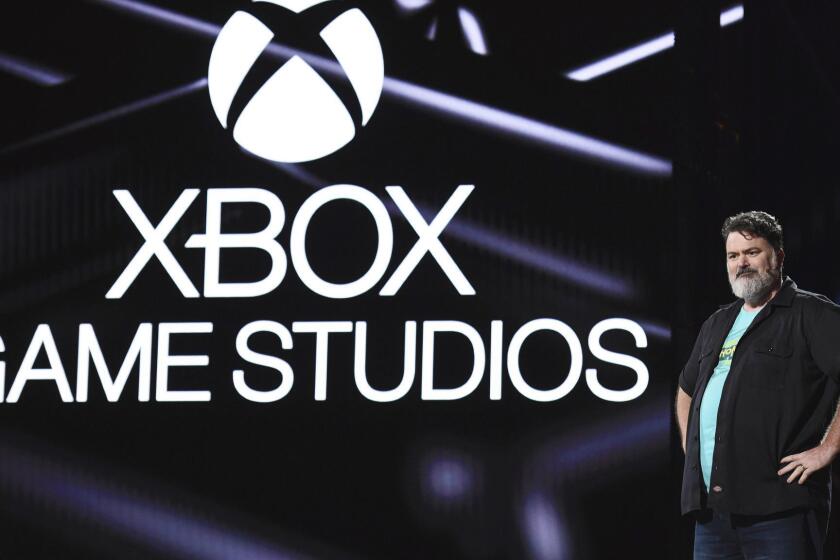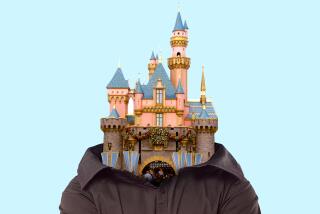Why streaming services need to embrace game design — and give users the illusion of ownership
This story is part of a Times series on the great streaming wars of 2019. Click here to read the rest of our coverage of Disney +, Apple TV +, HBOMax and more.
Long before Netflix unveiled interactive shows like “Black Mirror: Bandersnatch” and “Puss in Book: Trapped in an Epic Tale,” the service was experimenting with game-like techniques to keep viewers on its site. The very act of navigating the streamer was itself an elaborate strategy game, especially for those who shared accounts.
Netflix, after all, isn’t simply a place to binge watch. One can view it as a detailed personality engine, a trait I discovered the hard way when, after a few weeks of inactivity, my account was compromised. Where once had been a carefully sculpted yet imperfect roster of recommendations of Netflix originals, independent films and tons of animation was now all, more or less, “Desperate Housewives.” So long “Mary and the Witch’s Flower” and hello “NCIS.”
Yes, I had to change my password. But worse, I had to start over at essentially Netflix Level One.
It wasn’t as easy as I had hoped. Navigating the service from scratch after years of cultivation became an elaborate action game of scrolling and selecting while trying to avoid auto-playing trailers — with audio, no less! — and even sometimes passing over the very show or film I wanted to select. In this new era of everything streaming all the time, where high-profile players Disney+ and Apple TV+ will soon vie for our attention and dollars, content exploration matters deeply, as does presentation.
The teaser trailer of the streaming era is not a standard “coming attractions” commercial but an icon, a carefully sculpted image and title that must be clean and yet not so overly simplistic as to look cheap. In this à la carte era, the streaming services we choose will become our digital mood boards, an interactive, board-game-like setup that will reflect not just the tastes but the aesthetics of the player. If that sounds over the top, think back to “Sim City,” where menu design and icon creation not only make or break the experience but help drive it.
Look too toward the lessons from Nintendo Switch, the Japanese game-maker’s slick home console that doubles as a portable game machine. Here, menu curation has become something of a hobby among a certain sect of players, so much so that games can be threatened with a boycott for a tacky icon. At least one developer went so far as to release a teaser for its updated icon. With so much of our lives in the cloud or manifested on screens, no wonder we want — insist, even — that our streamer guides feel like home.
In this new world, a franchise king such as Disney should have a relatively easy go of things when it launches in November. Nearly all of Disney’s properties are recognizable via a symbol alone. And on pages with original content, recommended content, new content, vintage content, trending content, fictional content, non-fiction content, international content, content you started and stopped, and so on and so forth, a key to not being overwhelmed is familiarity. And some would argue that the key to making a click-worthy and save-worthy icon is in some ways Disney’s ace card. Already I know users will want to tinker with the Disney+ interactions, such as moving a cursor over the word “Disney” and seeing the castle logo materialize behind it.
Apple’s iTunes recognized a weakness of the mainstream music industry. Now Apple Arcade is disrupting gaming. A preview of the games to play
“I often compare a game’s icon to the logo on a superhero’s chest,” writes game designer and USC lecturer Scott Rogers in his game textbook “Level Up! The Guide to Great Game Design.” “Make it memorable, cool, or funny — whatever you think will best sum up your game. Because your icon will become your game’s identity.”
Those who consider themselves auteurs may cringe at a new single-image-based pop-culture currency, but think of it less as a statement on the type and/or quality of content and more of a balance between just enough information and too much information. Streaming services increasingly reflect the brand that owns them, and this will hold true even more with Disney+ and Apple TV+. Take, for instance, the bare-boned presentation of Amazon Prime, where the text-first display at the top represents convenience more than it does a lifestyle. You’re here for kitty litter, why not come back later for “The Marvelous Mrs. Maisel”?
Netflix has worked overtime to grip our attention and then never let go. When I was away from the service for about two months I came back to a screen displaying a number of shows I hadn’t heard of, some sprinkled among trending content, others down in the recommended section and still others uncovered only after I went hunting for original content. These were largely works that were well-reviewed but were invisible to anyone not regularly checking the Netflix ecosystem. It reminded me of playing the most recent “Red Dead Redemption,” where after a few hours on a Saturday I still hadn’t finished the tutorial and when my schedule finally allowed me to return in two weeks I more or less had to start from scratch, which meant never starting at all.
This is a common affliction for those of us who love games. Game play can often be somewhere between 30 hours and never-ending, meaning the one we pick is the one we go to bat with for the remainder of the year. Yet this also isn’t necessarily a negative. A key to our game-influenced digital lifestyle is the illusion of ownership, the appearance of collections when, in fact, there are none. These are the virtual clothes of “Fortnite” or the digital badges we earn for completing a mission in “The Last of Us.” This is Netflix saying, “Look at all this stuff you have.”
Early previews of Disney+, both from the company’s fan-focused D23 Expo and video posted from test markets, as well as extensive time spent with the latest incarnation of Apple’s TV app, indicate an attempt to bring a greater sense of order to the streaming arena. Disney, in particular, seems primed for this space, in part because Disney+ is the culmination of the Bob Iger era, a philosophy, as outlined in his autobiography “The Ride of a Lifetime,” that amid “an explosion of choice ... brands would become even more powerful tools for guiding consumer behavior.” One viewer may want “Marvel” or “Star Wars,” but Disney’s catalog can also be organized topically — “princesses” — or by decade.
“Where Cards Fall” originated at USC’s game school and has become a playable-for-all standout title on Apple Arcade.
Yet while it’s possible to explore a role-playing-game-like assortment of options, Disney+ keeps its primary screens direct with simple animations, unveiling the extras and bonus content only to those who go on the prowl for it. The interface shows a keen awareness of game design principles, especially in the ability to master the so-called HUD (heads-up display), where directional cues are given to a player. A good HUD is hard to make, but the best gives only information needed to the player in that specific moment, in turn allowing one to enjoy a mostly full display.
Icons that work with subtle and sharp animations dot Apple TV+, as well. A good icon lets users know it has been selected — a click, a change in color. A bad one tells us it’s been selected — loud noises, music, any elaborate video that auto-plays. Bless Apple for letting its trailers, when they appear, start on mute, giving the viewer control over how and what is heard. It’s a shift from Netflix, but an important one, a plea designed to earn attention rather than demand it. I have no idea if “Dickinson” or “For All Mankind” will be great shows, but the slight ways in which their digital cards spring to life let the user know where we are.
Apple has grander ambitions, however. It wants to be the hub through which we access all streaming content, and its app lets us know where shows and movies are available to stream or purchase — whether or not they are Apple TV+ content. Even better, you can click straight through and start watching shows on several competing services. This isn’t entirely seamless. Apple showcases those who have opted into being connected to the TV app, meaning CBS All Access’ “Star Trek: Discovery” is visible to me and easy to watch, yet I have to go hunting for Netflix’s “The Dark Crystal” and then separately go to Netflix to watch.
The struggle for Double Fine Presents to get the first “Psychonauts” released has become the stuff of modern game lore.
The goal is to create an ecosystem — a world — that allows us to linger, an app version of the all-in-one-place ability once exclusively held by cable providers.
Today, however, a list or a menu isn’t enough. Apple has replaced the cable listings of yore with a coldly modern look akin to an upscale furniture store, where clashing styles and looks can live harmoniously in a space-age-white backdrop. It all appears very pleasing and aspirational — all of this could be yours, it says — at least until you start adding up the cost of all the various subscriptions.
Of course, Apple’s originals get the prime real estate, and it’s perhaps no surprise that Apple’s design elegance handles the signifiers for its original content with grace. Such a detail won’t make a good show great or a bad one watchable, but it will stave off one of the gravest sins of the streaming era: being ignored.
More to Read
The complete guide to home viewing
Get Screen Gab for everything about the TV shows and streaming movies everyone’s talking about.
You may occasionally receive promotional content from the Los Angeles Times.









